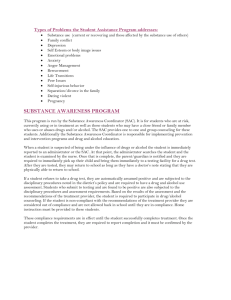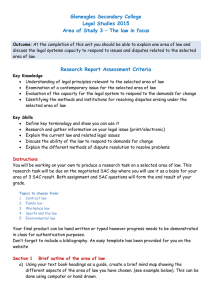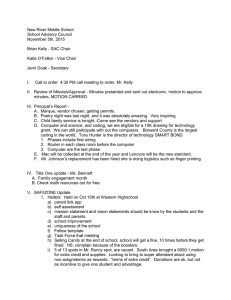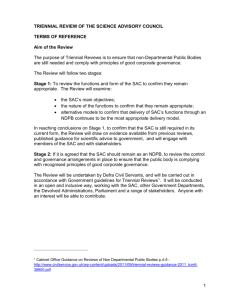School Budgets - Section for SAC Manual
advertisement
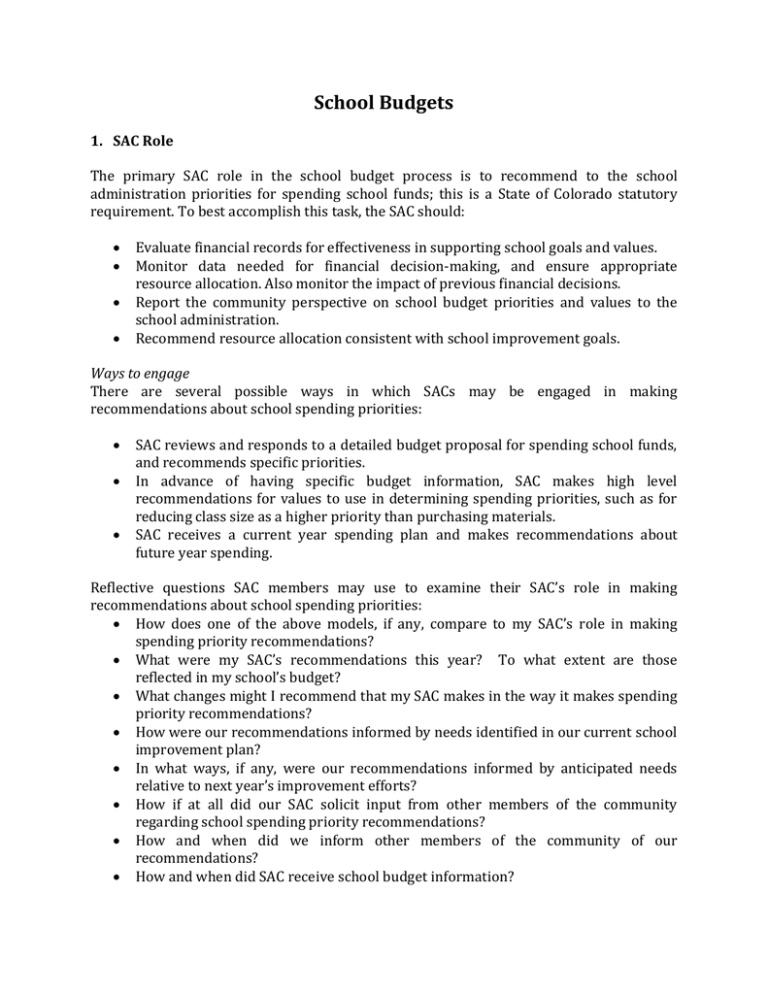
School Budgets 1. SAC Role The primary SAC role in the school budget process is to recommend to the school administration priorities for spending school funds; this is a State of Colorado statutory requirement. To best accomplish this task, the SAC should: Evaluate financial records for effectiveness in supporting school goals and values. Monitor data needed for financial decision-making, and ensure appropriate resource allocation. Also monitor the impact of previous financial decisions. Report the community perspective on school budget priorities and values to the school administration. Recommend resource allocation consistent with school improvement goals. Ways to engage There are several possible ways in which SACs may be engaged in making recommendations about school spending priorities: SAC reviews and responds to a detailed budget proposal for spending school funds, and recommends specific priorities. In advance of having specific budget information, SAC makes high level recommendations for values to use in determining spending priorities, such as for reducing class size as a higher priority than purchasing materials. SAC receives a current year spending plan and makes recommendations about future year spending. Reflective questions SAC members may use to examine their SAC’s role in making recommendations about school spending priorities: How does one of the above models, if any, compare to my SAC’s role in making spending priority recommendations? What were my SAC’s recommendations this year? To what extent are those reflected in my school’s budget? What changes might I recommend that my SAC makes in the way it makes spending priority recommendations? How were our recommendations informed by needs identified in our current school improvement plan? In what ways, if any, were our recommendations informed by anticipated needs relative to next year’s improvement efforts? How if at all did our SAC solicit input from other members of the community regarding school spending priority recommendations? How and when did we inform other members of the community of our recommendations? How and when did SAC receive school budget information? 2. Budget Overview The budget is a plan for balancing expenditures with revenues. It is based on estimates of data that become better known as the year progresses. The district superintendent prepares a budget that considers the needs and values of students, parents, employees, principals and taxpayers and presents it to the Board of Education. In the final stages of the budget process, the board must balance the needs of students, parents and employees with the fiscal responsibility it has to the taxpayers. The board is the final decision-maker on the budget. 2.1 Revenues All Boulder Valley residents pay taxes that support the schools — some directly through property and specific ownership taxes and others indirectly when businesses pass on the cost of taxes through the price of goods, services and rent. Schools are funded from basically three sources: local property tax, state funds and vehicle registration fees (known as specific ownership tax). Although the State determines individual school district funding levels, the amount contributed from the three different sources varies according to local property values. In addition to the state funding, Colorado law allows local school districts to ask voters to approve override funding through an additional mill levy. This is paid entirely with increased local property taxes. Boulder Valley voters generously approved such overrides in 1991, 1998, 2002, 2005, and 2010. All of these overrides were to help the district with operating costs. Funding from the most recent facilities bond approval in 2006 is restricted to capital expenditures, as were the last two such bond approvals in 1994 and 1999. Except with approved increases, the overall mill levy declines over time with a rise in assessed valuation. Table 1: BVSD Revenue Sources for FY2010-11 Property Taxes Other Local Revenue Sale of Fixed Assets Internal Service Revenue State Revenue Federal Revenue Services Provided to Charters Other Revenue Sources Total Revenue 199,579,466 38,708,998 20,000 24,759,988 65,923,952 4,266,544 4,018,519 10,844,274 348,121,741 2.2 Expenditures Education is a profession that relies on people — teachers and support personnel. Personnel costs (salaries and benefits) account for nearly 90 percent of Boulder Valley’s $210.7 million 2009-10 general operating fund expenditures. While budget discussions often focus on teachers, one cannot overlook the importance of the school support personnel — approximately half of the total district workforce —whose jobs ensure that teachers can focus their attention on the students. The budget also funds the necessary equipment, supplies and training that enable employees to fulfill their job responsibilities and to grow in their professions. Table 2: BVSD Expenditures for FY2010-11 Salaries Benefits Pro/Tech Services Property Services Other Services Supplies Property Other Uses Debt Services (Payment Debt) Total Expenditures 174,907,779 46,237,314 5,739,961 5,113,197 32,546,386 16,884,075 97,063,402 42,637,189 11,535,000 on 432,664,303 2.3 School budgets Principals are the managers of their schools and must be accountable to multiple groups at the school level such as parents, students and staff. They also are accountable at the district level to the superintendent, his staff and the Board of Education, and they must also meet multiple state and federal requirements. Principals make recommendations for hiring the staff to carry out the educational programs, and they manage the school’s non-salary (operating) budget: Staff – teachers, paraprofessionals, principals, office personnel, custodians, and other staff. Operating – supplies, copier costs, equipment, staff development, leadership, and student accounting system expenses. Textbook funds are budgeted centrally and distributed to schools based on a textbook adoption calendar. 2.3.1 Staff budget allocations Instead of a staff budget based on dollars, schools receive an allocation of staff positions called “full-time equivalents” (FTE). The FTE allocation is based on each school’s student population enrollment and programmatic needs. Enrollment estimates are made in the spring so that principals can receive preliminary FTE allocations and make programming decisions. Staffing is adjusted in August when the students arrive and actual enrollment is known. Staff positions for special programs, such as special education, talented and gifted, or English as a Second Language, are allocated by the district based on the number of students who will need those services. 2.3.2 School resource allocations Each school receives a school resource allocation (SRA) based on the school’s enrollment. Over 80 percent of the total SRA in Boulder Valley is budgeted for instructional needs at the school site. The SRA pays for classroom budgets, copiers and paper, office supplies, library materials, custodial supplies, field trips, limited staff and curriculum development. Principals work with their staffs and SAC to decide how to budget the SRA in ways that best support the school’s goals and needs. 2.4 Budget Timeline An ideal timeline for budget development, SAC input, decision-making, expenditures, and SAC review for one fiscal year is illustrated in Figure 1. Figure 1. Timeline for budget development. This calendar may change year-to-year. 2.4.1 Planning The school fiscal year begins on July 1 and ends on June 30. Budget planning begins some 7 months prior to this, in November-December, after the State releases initial district funding projections. The State revises these projections throughout the year. Starting in January, the District solicits input on budget priorities from staff, parent groups, and the community at large through a variety of methods including surveys, focus groups, meetings, and a Budget Advisory Committee. During this time, each school should engage school parents and the local community as to their recommendations for school spending priorities. SAC should summarize and document their recommendations, and present them to the school administration and to DAC. School staffing projections are sent out by the District in March, based on student enrollment projections. School administration aligns these staffing allocations with budget priorities and school goals recommended by SAC and school staff to develop a school budget. In April, the Board of Education begins reviewing different budget options presented by the District. District staff and the Board work together to see that instructional priorities guide budget priorities as much as possible. Revised State funding projections, along with budgets submitted by each school, are integrated into the District budget in May. The Board reviews the District budget, then approves the budget in June before the fiscal year begins. 2.4.2 Fiscal Year The school fiscal year begins on July 1. At this time, schools may begin spending funds in preparation for the new school year. In August, schools use revised projections of student enrollment to request that the District adjust school staffing allocations. If approved, the school revises their budget in alignment with school priorities. The official count of student enrollment, by school, that sets State FTE funding occurs on October 1 – known as the “October count”. The District uses these numbers, along with the latest financial projections from the State, to revise the district budget. This revised budget is reviewed by the Board and approved in December. SAC reviews school budget expenditures in the January timeframe, to ensure that school spending aligns with school priorities and goals. In February, the District uses final revenue and student enrollment numbers to conduct a mid-year financial analysis. When the fiscal year ends on June 30, the District accounts for all revenues and expenditures by balancing its books. 3. Best Practices Educate – school administration ensures that SAC members (school staff, parents and the community) are educated about the school budget process. This education may come from the school administration, such as meetings or presentations, and from the district, in materials such as this SAC Best Practices Manual. Solicit – school administration engages the school community through the SAC about budget choices. SAC gives voice to parent budget priorities and values. SAC should also ensure that proposed resource allocations align with school improvements goals. For example, cutting library funding would not align with goals targeting literacy improvement. SACs might form Finance Subcommittees to help fulfill this school budget review role. Inform – school administration informs the SAC and the larger school community about budget decisions that have been made. 4. Glossary of Terms Assessed Valuation: The taxable value of real and personal property as determined by a tax assessor or government agency as a basis for levying taxes. Assessed valuation does not necessarily correspond to the property’s market value. Benefits: District provided retirement (Colorado PERA), health and dental coverage, longterm disability, and life insurance. Benefits also include voluntary participation in 401(k), 403b and 457 defined contribution plans, flexible spending accounts in addition to vacation, annual leave, personal, and sick days depending on the job classification. For some job classifications, benefits also include longevity pay, tuition reimbursement and Leave of Absence opportunities. Board of Education (BOE): The 7-member elected policy-making body for BVSD whose primary functions are to establish policies for the district; provide guidance for the general operation and personnel of the district; and oversee the property, facilities, and financial affairs of the district. Members are elected to four-year terms, and may serve no more than two terms. Boulder Valley School District (BVSD): Includes a large part of Boulder County, a significant portion of western Broomfield County and a small piece of Gilpin County. This area incorporates the cities of Boulder, Broomfield, Erie, Gold Hill, Jamestown, Lafayette, Louisville, Nederland, Superior, Ward and unincorporated South Boulder County. Budget: A plan of future events including anticipated revenues and expenditures, along with the financial position at some future point in time. Capital Expenditures: Those expenditures that result in the acquisition of or addition to fixed assets. Colorado Department of Education (CDE): State department that funds Colorado’s 178 school districts. District Accountability Committee (DAC): DAC operates in accordance with the Legal Guidelines for the Boulder Valley School District Accountability Committee, Board Policy AF-E, and the Colorado Accreditation Program. The board of education, in cooperation with the DAC, (1) establishes an accountability program to measure the adequacy and efficiency of educational programs offered by the district; (2) consults with the DAC to compile school building goals/objectives/plans and (3) reports the district’s goals/objectives/plans to improve educational achievement, maximize graduation rates, and increase the ratings for each school’s accreditation category to the public. English as a Second Language (ESL): The BVSD program that supports and provides services for the ELL student. English Language Learner (ELL): A student who has a home, primary or first language that is not English and who has not yet achieved proficiency in the English language. In BVSD, a student is identified as ELL by meeting both of the following criteria: 1) the parent has filled out a Home Language Survey identifying the significant presence of a language other than English in the home and 2) the student is determined to have limited English proficiency, as measured by the Woodcock-Muñoz Language Survey. Students identified as ELL continue to be considered ELL until they have attained English language proficiency. Expenditures: Decreases in net financial resources. Expenditures include current operating expenses that require the current or future use of net current assets, debt service, and capital outlays. Fiscal Year: The twelve-month period of time to which the annual budget applies. All Colorado school districts, by law, must observe a fiscal year that is July 1 through June 30. Full Time Equivalent (FTE): An allocation of staff positions that a school receives from the district, instead of a dollar amount. The allocation is based on each school’s student population enrollment and programmatic needs Mill Levy: The rate of taxation. A mill is one-tenth of a cent ($.001). Mill levies are expressed in dollars per thousand, i.e., one dollar for each $1,000 of assessed value. Override Revenues: A school district can seek authorization from its voters to raise and expend “override” property revenues via an additional mill levy. BVSD held Special Elections in November of 1991, 1998 and 2002 for the amounts of $7,062,468, $10,600,000 and $15,000,000 respectively. The total each year of $32,662,468 is used to support programs in the General Operating Fund. Parent(s): Parent, guardian or other persons with legal authority to make educational decisions for children. Pupil Enrollment: The number of pupils enrolled on October 1 during the budget year or the school day nearest to said date, as evidenced by the actual attendance of each pupil prior to said date. This is sometimes referred to as the head count. Revenue: Funds received, generally from taxes or from a state or federal funding program, which are not loans and which do not cause an increase in a liability account. Salary: The total amount paid to an individual, before deductions, for personal services rendered while on the payroll of the district. School Accountability Committee (SAC): The SAC functions as an advisory committee to the school on issues related to school improvement, accreditation and accountability. Roles/responsibilities include: review of accountability reports and involvement in school goals/planning, budget, safe school plan, and educational programs. School Resource Allocation (SRA): General Fund resources provided to the schools to be used to pay for day-to-day operating expenditures of the building. Specific Ownership Tax: An annual tax imposed upon each taxable item of certain classified personal property such as motor vehicles. The tax is computed by the County Clerk in accordance with state schedules applicable to each sale of personal property. Special Education Program (SPED): A special curriculum consisting of courses and other provisions which are different from or provided in addition to those provided in the usual school program and are provided for exceptional pupils by specially qualified personnel. Supplies: Consumable material used in the operation of the school district including fuel and natural gas, food, textbooks, paper, pencils, office supplies, custodial supplies, maintenance materials and software. Talented And Gifted (TAG): Program for children between the ages of 5 and 21 whose abilities, talents, and potential for accomplishment are so outstanding that they require special provisions to meet their educational needs. 5. Acronym Reference BOE BVSD CDE DAC ELL ESL FTE PERA SAC SPED SRA TAG Board of Education Boulder Valley School District Colorado Department of Education District Accountability Committee English Language Learner English as a Second Language Full Time Equivalent Public Employees Retirement Account School Accountability Committee Special Education Program School Resource Allocation Talented and Gifted 6. Additional Online Resources CDE role of SAC BVSD 2010 Budget Perspectives
